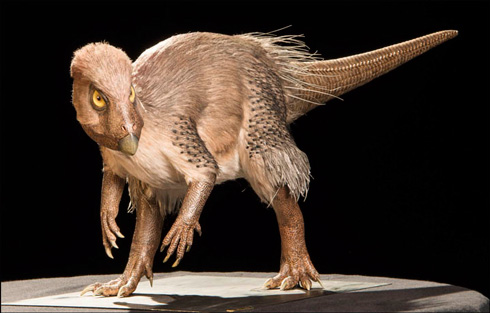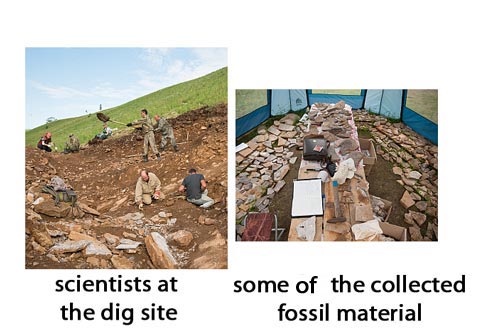A Feathered Middle Jurassic Plant-eater – Kulindadromeus
A team of international scientists have created a life-size model of the dinosaur they named and described two years ago. The dinosaur, called Kulindadromeus (pronounced cull-lind-ah-dro-me-us), was only around one metre in length. It was quite small, when most people think of dinosaurs as being huge animals. Size is not everything when it comes to the dinosaurs. As Kulindadromeus represents a member of the bird-hipped group of dinosaurs and fossil evidence suggest that this little reptile had feathers.
Kulindadromeus
A Model of the Plant-eating Dinosaur Kulindadromeus
Picture credit: T. Hubin/RBINS
Important Fossil Discovery
Many hundreds of fossils of this herbivorous dinosaur were found by field expeditions to a site on the river Olov in Siberia (Russia). It was from these fossils that scientists were able to work out that this dinosaur ran around on its two hind legs, that it had five toes on each foot, a beak, a long scaly tail and most importantly of all, that it had feathers on its body. The largest feathers seem to be confined to the top of the legs and arms with another set of feathers protruding from the animal’s rump.
Some of the Extensive Fossil Material Collected by the Palaeontologists
Picture credit: Royal Belgian Institute of Natural Sciences
A Middle Jurassic Dinosaur
The fossil material comes from finely grained sedimentary rocks that were laid down in the Middle Jurassic (between 175 and 160 million years ago). The joint Russian and Belgian field team also found plant and insect fossils. The strata represents a watery, lakeside environment that had horsetail plants growing in the shallow lake margins. A number of Kulindadromeus individuals have been identified from the fossil remains and by studying the fossil material, the scientists have been able to build up an accurate picture of what this dinosaur actually looked like.
The life-size replica and a model of the skeleton of Kulindadromeus (shown below), is currently on display at a museum in Japan.
A Model of the Skeleton of Kulindadromeus
Picture credit: T. Hubin/RBINS
Many scientists have concluded that one group of dinosaurs the theropods, a group that consisted of mainly meat-eating dinosaurs were feathered. The theropods were lizard-hipped dinosaurs, the discovery of Kulindadromeus suggests that bird-hipped dinosaurs were also probably covered in feathers.




